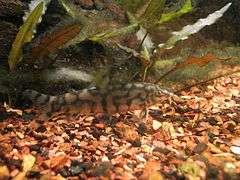Yoyo loach
| Yoyo loach | |
|---|---|
 | |
| Typical aquarium specimen labelled as Botia almorhae, but these are likely a related species (see text).[1][2] | |
| Scientific classification | |
| Kingdom: | Animalia |
| Phylum: | Chordata |
| Class: | Actinopterygii |
| Order: | Cypriniformes |
| Family: | Botiidae[4] |
| Genus: | Botia |
| Species: | B. almorhae |
| Binomial name | |
| Botia almorhae J. E. Gray, 1831 | |
| Synonyms | |
|
Botia grandi Gray, 1832[4] | |
The yoyo loach, Almora loach or Pakistani loach (Botia almorhae) is a freshwater fish belonging to the loach family Botiidae. It originates in the slow-running and still waters of the Ganges basin in northern India and possibly Nepal.[1][2] Despite the alternative common name Pakistani loach, the true B. almorhae is not known from Pakistan (the species in this country is B. birdi).[1][2]
It may attain a length of 14–16 cm (5.5–6.3 in), and is named for its dark and pale patterns, which often can be seen to spell "yoyo" (especially in smaller/younger specimens), hence the common name yoyo loach.[1] The final common name, Almora loach, refers to Almora in Uttarakhand, India.[4] Specimens labelled as B. almorhae are commonly found in the aquarium trade, but most (if not all) of these appear to be the closely related B. lohachata, two possibly undescribed species popularly referred to as B. sp. "Kosi" and B. sp. "Teesta", or hybrids.[1][2]
In the aquarium
The yoyo loach is frequently kept in aquariums and is relatively docile toward most other aquarium inhabitants. It is fairly hardy and open to water conditions, but has a tendency to prefer soft, acidic water, from a pH of 6 to around 7.4; however, with gradual acclimation, they tolerate rather hard, alkaline water, even up to a pH of 8. As tropical fish, they prefer temperatures in a range from 24 to 27 °C (75 to 80 °F). Yoyo loaches prefer to be kept in slow-moving water, although some individuals have shown preference for faster moving waters. Lacking other fish or plants in their environment, the yoyo loach may become stressed. The yoyo loach can be kept comfortably with a small group of Otocinclus catfish, other loaches, as well as other passive fish. This fish can live for 20 or more years.
In the aquarium, the yoyo loach has a tendency to hide occasionally, especially sharing the tank with aggressive fish. They prefer to have caves in which they can fit snugly and will ignore open caves. They will eat a variety of foods, such as processed flake or pellet food, frozen foods, and freeze-dried foods. When they feed, they generate 'clicking' noises. These same sounds can sometimes be observed while they are swimming. These clicking sounds are generated when the loach grinds its pharyngeal teeth. The yoyo loach will eat smaller snails in the aquarium.
See also
- List of freshwater aquarium fish species
- The Aquarium Wiki Encyclopaedia—Care information for yoyo loaches
References
- Froese, Rainer and Pauly, Daniel, eds. (2014). "Botia almorhae" in FishBase. 09 2014 version.
- "Botia almorhae". Integrated Taxonomic Information System. Retrieved 12 June 2006.
- 1 2 3 4 5 SeriouslyFish: Botia almorhae. Retrieved 15 July 2014.
- 1 2 3 4 Grant, S. (2007). Fishes of the genus Botia Gray, 1831, in the Indian region (Teleostei: Botiidae). Ichthyofile 2: 1-106
- ↑ Chaudhry, S. (2010). "Botia almorhae". IUCN Red List of Threatened Species. Version 2014.1. International Union for Conservation of Nature. Retrieved 15 July 2014.
- 1 2 3 Kottelat, M. (2012): Conspectus cobitidum: an inventory of the loaches of the world (Teleostei: Cypriniformes: Cobitoidei). The Raffles Bulletin of Zoology, Suppl. No. 26: 1-199.
| Wikimedia Commons has media related to Botia almorhae. |
